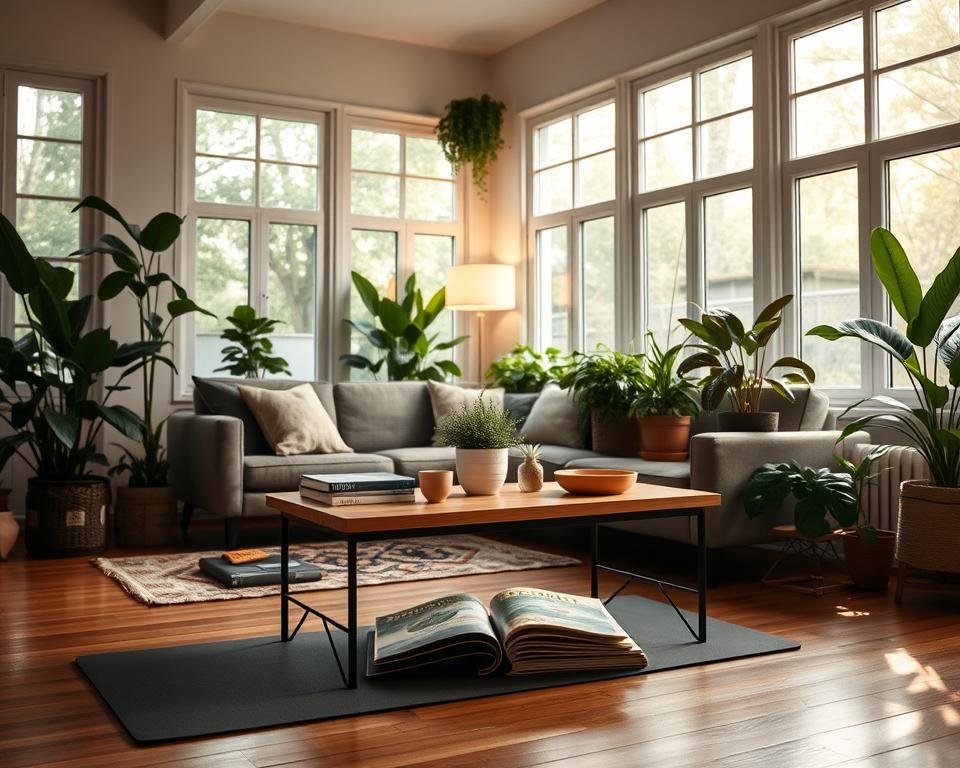Keeping a healthy lifestyle at home is key to better well-being and quality of life. This guide offers insights and strategies for “healthy living at home” and “healthy living home health care.” It covers making your home safe and sustainable, finding “healthy living home health” resources, and budgeting tips.
If you want to stay independent, manage a chronic condition, or focus on your health, this guide is for you. It provides practical tips and information on support services. You’ll learn how to make choices that support your “healthy living home health” journey.
Ensuring a Healthy Home Environment
Creating a healthy home is key for our well-being. We need to focus on two main things: avoiding harmful chemicals and making our homes energy efficient and sustainable.
Avoiding Health-Harming Chemicals
The Environmental Working Group (EWG) says we should watch out for chemicals in our homes. Things like paints, varnishes, and glues can harm our health. Using products with fewer VOCs can help keep us safe.
Old homes might have lead-based paint, which is very dangerous, mainly for kids. Asbestos in buildings is also a big risk if it’s disturbed. It’s important to test for these and get them removed safely.
Promoting Energy Efficiency and Sustainability
Using energy-efficient and sustainable methods makes our homes healthier. Keeping fireplaces in good shape is important to avoid harmful gases. Using HEPA filters in air purifiers can also clean the air we breathe.
Choosing the right products and materials for our homes helps avoid harmful substances. This makes our homes better for us and the planet, creating a healthier space for everyone.
The Importance of Aging in Place
Many older adults want to stay independent and live in their own homes as they get older. This idea is called “aging in place.” It needs careful planning and knowing what care is available. It’s important to look at current and future needs and what resources are out there.
Home support often comes from family, friends, and neighbors. They help with things like getting to the doctor or grocery shopping. The text says that governments offer many resources for older adults and their families.
Money from savings, pensions, investments, and home sales can help pay for care at home. The text stresses the importance of planning for the care needed to age in place.
“Nearly 90% of adults over 65 wish to remain in their current homes as they age according to AARP data.”
Aging in place lets older adults keep their independence and stay connected to their communities. An active social life can prevent dementia. This motivates many to stay in their own homes.
Gerontologists and care managers help older adults with home renovations, finances, and in-home care. They make it easier for older adults to live independently in their own homes as they age.
Assessing Your Current Needs
Keeping a healthy lifestyle at home starts with knowing your needs. Look closely at areas where you might need help, like personal care and household chores. This helps figure out how much support you need to stay independent and healthy.
Personal Care Assistance
Personal care tasks like bathing, dressing, and grooming are key to your health and dignity. Check if you can do these tasks on your own. If not, you might need help from family, friends, or professionals to meet your care needs.
Household Chore Support
Keeping your home clean and organized is important for a healthy life. See if you can handle tasks like cleaning, grocery shopping, and laundry. If not, consider hiring a cleaning service or asking loved ones for help. This way, you can focus on your health and well-being.

“Understanding your current care needs is the first step towards creating a customized plan for healthy living at home.”
Planning for Future Health Conditions
It’s important to think about future health needs when you’re focusing on today’s health. Planning ahead and talking to doctors can help you understand your health better. This way, you can make sure you have the support you need to live well at home.
Anticipating care needs and managing chronic conditions are key to a healthy life later on. Regular doctor visits and talking to your healthcare team are essential. They help you spot issues early and plan how to handle them. This might mean getting new technology, changing your home, or getting more help at home.
“Planning for future health conditions is not just about managing illnesses, but also about preserving your overall well-being and maintaining the lifestyle you cherish.”
By planning for future health, you can take charge of your care. This ensures your needs are met, whether it’s a long-term illness or a new health problem. This approach gives you peace of mind and the support to live well at home.

The secret to good planning for future health is to stay informed and talk openly with your doctors. Make choices that fit your goals and what you want. This way, you can create a plan that helps you stay healthy and independent for a long time.
Exploring Available Resources
When thinking about staying healthy at home, knowing about different resources is key. These include informal caregivers like friends and family, and formal services from professionals and community programs.
Informal Caregivers: Friends and Family
Many older adults count on help from informal caregivers, like spouses or adult children. They assist with daily tasks and offer companionship. It’s vital to make sure these caregivers get the support they need to avoid burnout.
Formal Services: Professional Care and Support
There are also formal and community programs for healthy living at home. These include in-home medical care, therapy, and meal delivery. Looking into these options in your area can help you create a plan tailored to your needs.
Budgeting for Healthy Living at Home
Living healthily at home needs careful money planning. You might need to set aside money for things like medical alert systems and monitoring, adult day care, transportation, home health care, and companion or meal delivery services. Knowing the costs helps you make a budget. It also helps find ways to get the help you need to stay healthy at home.
Medical Alert Systems and Monitoring
Medical alert systems offer peace of mind and quick help in emergencies. They usually cost between $20 to $50 a month. This depends on the features and how much monitoring you need.
Adult Day Care Services
Adult day care centers are great for seniors. They offer supervision, social time, and activities. Prices vary a lot, from $25 to $100 a day. This depends on where you are and the care you need.
Transportation Services
Good transportation is key for staying independent. It lets you get to healthcare, errands, and social events. Costs can be from $5 to $50 per trip. This depends on the service and how far you go.
Home Health Care Services
In-home care, like nursing or homemaking help, can be pricey. Costs are from $20 to $40 an hour or more. This depends on the care needed and who provides it.
Companion and Meal Delivery Services
Companion and meal delivery services ease meal prep and offer social time. Prices are usually from $10 to $30 per visit or meal. This varies based on the service and where you are.
Knowing these costs helps you plan. It ensures you can get the help you need to live healthily and independently at home.
Ensuring Safety and Independence
Keeping a home safe is key for older adults who want to stay in their homes. Home safety and fall prevention are vital. They help seniors stay independent and avoid serious injuries.
Falls are the top cause of injury and death for older adults, says the Centers for Disease Control and Prevention. Simple safety steps like grab bars, removing tripping hazards, and good lighting can help a lot. These actions make homes safer and reduce fall risks.
Fall Prevention Strategies
Home changes aren’t the only solution. Exercises that improve balance and using assistive devices also help. Regular exercise boosts strength, flexibility, and coordination. Mobility aids like walkers or canes offer extra support and stability.
“Making at least one major modification per year can help in making a home more age-friendly for the elderly.”
By focusing on safety and independence, older adults can live better lives at home. A proactive approach to preventing falls and keeping homes safe lets seniors enjoy their golden years with confidence and peace of mind.
Working with Care Management Teams
Working with care management teams can greatly help you live healthily at home. They know exactly what you need and create a plan just for you. They also connect you with community resources and services.
Care management teams include nurses, social workers, and other healthcare experts. They help manage your care and health concerns. They offer support for recovery, managing chronic conditions, and even dementia care.
These teams are great at finding community resources for you. They give you info on drug coverage and local health services. This way, you get the support you need to stay independent and healthy.
A study showed that 200 out of 1,000 patients could benefit from care management. This targeted support is key, as the top 1% of Americans spend 80% of healthcare costs. Working with a care team helps you manage your health and avoid expensive hospital visits.
If you have a chronic condition, are recovering, or want to stay independent, a care team is a great help. They offer the care and support you need to thrive at home.
Healthy Living at Home: Resources and Tools
Living healthy at home is easier with the many resources and tools out there. You can find online health libraries and drug search databases. There are also programs and services for older adults and those with special needs to help them stay independent and well.
For detailed health info, check out sites like the National Institutes of Health (NIH) and the Centers for Disease Control and Prevention (CDC). They have lots of reliable, current info on health topics. This includes managing chronic conditions and keeping a healthy lifestyle.
Many communities offer special programs and services for healthy living at home. You might find adult day care centers, transportation services, and in-home care providers. Connecting with local groups can help you find the support you need to thrive at home.
Online tools are also very helpful for managing your health. You can use drug search databases to look up medication info. And provider directories to find healthcare professionals in your network. Using these tools can help you make better care choices and stay active in your health.
By using the many home health resources, tools for healthy living, and community support, you can live a healthy lifestyle. Start your journey towards a healthier, more independent future at home.
Conclusion
This guide has covered the key parts of healthy living at home. It shows how to make your home safe and sustainable. It also talks about planning for care needs now and in the future.
Using the resources and tips from this article, you can start a journey to better health at home. The main points highlight the need for summary of healthy living at home. They help people embrace home health and make smart choices for their healthy living at home.
This guide is a great tool for navigating the changing world of health and wellness. It gives readers the tools to create a caring and self-sufficient home. By following these ideas, people can keep their health and independence. They can do this while staying in the comfort of their own homes.




4 thoughts on “Healthy Living at Home: A Simple Guide to Home Health Care”
Comments are closed.